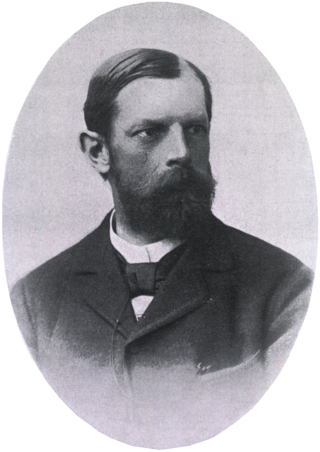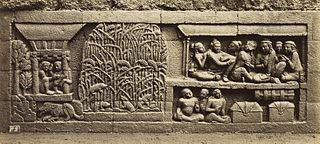The Iron Age is the final epoch of the three-age division of the prehistory and protohistory of humanity. It was preceded by the Stone Age and the Bronze Age. The concept has been mostly applied to Iron Age Europe and the Ancient Near East, but also, by analogy, to other parts of the Old World. It is also considered the third phase, of three, in the Metal Ages.

The Neolithic or New Stone Age is an archaeological period, the final division of the Stone Age in Europe, Asia and Africa. It saw the Neolithic Revolution, a wide-ranging set of developments that appear to have arisen independently in several parts of the world. This "Neolithic package" included the introduction of farming, domestication of animals, and change from a hunter-gatherer lifestyle to one of settlement. The term 'Neolithic' was coined by Sir John Lubbock in 1865 as a refinement of the three-age system.

A plough or plow is a farm tool for loosening or turning the soil before sowing seed or planting. Ploughs were traditionally drawn by oxen and horses but in modern farms are drawn by tractors. A plough may have a wooden, iron or steel frame with a blade attached to cut and loosen the soil. It has been fundamental to farming for most of history. The earliest ploughs had no wheels; such a plough was known to the Romans as an aratrum. Celtic peoples first came to use wheeled ploughs in the Roman era.
The 5th millennium BC spanned the years 5000 BC to 4001 BC. It is impossible to precisely date events that happened around the time of this millennium and all dates mentioned here are estimates mostly based on geological and anthropological analysis.

Shifting cultivation is an agricultural system in which plots of land are cultivated temporarily, then abandoned while post-disturbance fallow vegetation is allowed to freely grow while the cultivator moves on to another plot. The period of cultivation is usually terminated when the soil shows signs of exhaustion or, more commonly, when the field is overrun by weeds. The period of time during which the field is cultivated is usually shorter than the period over which the land is allowed to regenerate by lying fallow.

Slash-and-burn agriculture is a farming method that involves the cutting and burning of plants in a forest or woodland to create a field called a swidden. The method begins by cutting down the trees and woody plants in an area. The downed vegetation, or "slash", is then left to dry, usually right before the rainiest part of the year. Then, the biomass is burned, resulting in a nutrient-rich layer of ash which makes the soil fertile, as well as temporarily eliminating weed and pest species. After about three to five years, the plot's productivity decreases due to depletion of nutrients along with weed and pest invasion, causing the farmers to abandon the field and move to a new area. The time it takes for a swidden to recover depends on the location and can be as little as five years to more than twenty years, after which the plot can be slashed and burned again, repeating the cycle. In Bangladesh and India, the practice is known as jhum or jhoom.

Subsistence agriculture occurs when farmers grow crops to meet the needs of themselves and their families on smallholdings. Subsistence agriculturalists target farm output for survival and for mostly local requirements, with little or no surplus. Planting decisions occur principally with an eye toward what the family will need during the coming year, and only secondarily toward market prices. Tony Waters, a professor of Sociology, defines "subsistence peasants" as "people who grow what they eat, build their own houses, and live without regularly making purchases in the marketplace".

The Neolithic Revolution, or the (First) Agricultural Revolution, was the wide-scale transition of many human cultures during the Neolithic period from a lifestyle of hunting and gathering to one of agriculture and settlement, making an increasingly large population possible. These settled communities permitted humans to observe and experiment with plants, learning how they grew and developed. This new knowledge led to the domestication of plants into crops.

Agriculture began independently in different parts of the globe, and included a diverse range of taxa. At least eleven separate regions of the Old and New World were involved as independent centers of origin. The development of agriculture about 12,000 years ago changed the way humans lived. They switched from nomadic hunter-gatherer lifestyles to permanent settlements and farming.
Mixed farming is a type of farming which involves both the growing of crops and the raising of livestock. Such agriculture occurs across Asia and in countries such as India, Malaysia, Indonesia, Afghanistan, South Africa, China, Central Europe, Canada, and Russia. Though at first it mainly served domestic consumption, countries such as the United States and Japan now use it for commercial purposes.

Hans Ernst August Buchner was a German bacteriologist who was born and raised in Munich. He was the older brother of Eduard Buchner (1860–1917), winner of the 1907 Nobel Prize in Chemistry.

Dilbat was an ancient Sumerian minor tell located southeast from Babylon on the eastern bank of the Western Euphrates in modern-day Al-Qādisiyyah, Iraq. The ziggurat E-ibe-Anu, dedicated to Urash, a minor local deity distinct from the earth goddess Urash, was located in the center of the city and was mentioned in the Epic of Gilgamesh.

The Song of the hoe or the Creation of the pickax is a Sumerian creation myth, written on clay tablets from the last century of the 3rd millennium BCE.

The Jeulmun pottery period is an archaeological era in Korean prehistory broadly spanning the period of 8000–1500 BC. This period subsumes the Mesolithic and Neolithic cultural stages in Korea, lasting ca. 8000–3500 BC and 3500–1500 BC, respectively. Because of the early presence of pottery, the entire period has also been subsumed under a broad label of "Korean Neolithic".
Arthur Golf was a German academic agronomist. A principal focus of his teaching and research was on "colonial agriculture": another was "selective breeding", concentrating on sheep. During his later years he was a professor at Leipzig University where between 1933 and 1935, and again during 1936/37, he served as University Rector.

The history of rice cultivation is an interdisciplinary subject that studies archaeological and documentary evidence to explain how rice was first domesticated and cultivated by humans, the spread of cultivation to different regions of the planet, and the technological changes that have impacted cultivation over time.
The farming/language dispersal hypothesis proposes that many of the largest language families in the world dispersed along with the expansion of agriculture. This hypothesis was proposed by archaeologists Peter Bellwood and Colin Renfrew. It has been widely debated and archaeologists, linguists, and geneticists often disagree with all or part of the hypothesis.

Ethiopia is considered the area from which anatomically modern humans emerged. Archeological discoveries in the country's sites have garnered specific fossil evidence of early human succession, including the hominins Australopithecus afarensis and Ardipithecus ramidus. Human settlements in present-day Ethiopia began at least in the Late Stone Age, and the agricultural revolution took place in the third millennium BCE. Ethnolinguistic groups of Afroasiatic speakers and Nilo-Saharan speakers—defined by new ethnic, cultural, and linguistic identities—emerged around 2000–1000 BCE.












